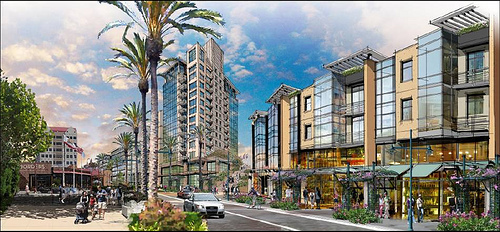News & Awards.
including honors for “Best Mixed Use,”
“Best Office,” and “Best Historic Rehabilitation”.

While at the AIA convention (I'm not an architect but still want to be one when I grow up) last week, I attended a presentation on the redevelopment of the Marketplace site in Emeryville, California, right across the Bay Bridge from San Francisco, south of Oakland. The new project, planned as a walkable, mixed-use, transit-accessible development, was the first of the participants in the LEED for Neighborhood Development pilot program to achieve platinum certification, the highest level.
(A fully revised set of standards for LEED-ND was published for public comment last Friday, and I encourage readers to weigh in with their views. I'll have more to say about that soon.)
Emeryville Marketplace is a 17-acre site currently fashioned in typical 1980s suburban commercial fashion: there's a 100,000-square-foot office building, a movie complex, Borders Books, a coffee & tea shop, and a longstanding public market that includes a "certified green food court" featuring immigrant businesses, and lots and lots (some 1100 spaces) of surface parking. Not a bad collection of uses, as these things go (see photos), but the block is completely oriented to cars, not people; there is a real lack of design coherence; whatever walkability exists is haphazard at best; there is no residential component; and there is a pedestrian connection to a major train station right across a bevy of railroad tracks, but it is underutilized.
Underneath it all is an old brownfield property (not uncommon in Emeryville, a community with an industrial history) that was capped and contained in accordance with the environmental standards of the day when the current use was built.
One of the challenges that the property owner and developer, TMG Partners, faces with its new plans for the site is that much of it is in current use under multi-year leases. TMG plans to build on excess surface parking around the current uses while they are still under lease, and complete the project over a 20-25 year time horizon. The first phase, according to the developer, will comprise rental housing and offices. Denise Pinkston of TMG told the AIA audience that their goal is to replace all of the surface parking with "places for people."
Eventually the plans call for 670 residences (20 percent of them will be affordable to lower-income populations), 180,000 square feet of new retail space, and an additional 120,000 square feet of offices. The rich mix of walkable urban features (see renderings) will be complemented by green roofs, native landscaping, and the expansion and upgrading of a current, underutilized park that will be fully integrated into the new neighborhood. All of these features helped the project earn credit points under LEED-ND, as did the terrific location on an urban redevelopment site.
In addition to TMG, Emeryville Marketplace will be developed with the assistance of Heller Manus Architects and landscape designers David Gates & Associates. Presenting at the AIA session were Jeff Heller of Heller Manus, Denise Pinkston of TMG, and Bill Worthen of Simon & Associates, the project's green building consultants.
Jeff Heller explained that Emeryville's candidacy for redevelopment changed in the 1990s when the suburb was chosen to house the principal Bay Area railroad station for Amtrak's north-south "long line" trains running east of the San Francisco Bay. This transformed the city into a "transit-centric" (Jeff's phrase) target for growth. The Marketplace site is right across the tracks from the station, which can be accessed via a pedestrian overpass.
The city of Emeryville had a big hand in fostering a true urban neighborhood concept for the site. According to a story in San Francisco Business Times, the small city, which takes up just over a square mile of space, is encouraging the creation of more mixed-use developments like this one in its general plan. One result was a much more ambitious plan for the Marketplace site than originally envisioned by TMG. From the article:
"'It really adds to the quality of life to have a city where you can walk to different places,' said Helen Bean, Emeryville's director of economic development and housing. 'Emeryville is bisected by the railroad and I-80, so anything we can do to connect it more is what the people have wanted and what we're trying to do.'
"The site's new design will include expansion of an existing market space into a much larger operation similar to Seattle's Pike Place Market, as well as narrower streets, additional walk ways and a city park that will double in size . . ."
Aimee Lewis Strain, writing in the local real estate publication The Registry, further reports that the design team worked with the city to host more than 30 community meetings in a four-year planning and environmental review process in order to understand the needs of the local community. Ultimately the City Council voted to rezone the Emeryville Marketplace site in accordance with the refined plans.
Despite the proximity to Amtrak and commuter rail, the site is not, unfortunately, convenient to BART, the region's rapid transit system. The nearest BART station is about a mile away, and not via an inviting walking route in any case. But, some time ago, TMG, an owner of multiple properties in the area, banded together with several other property owners to establish a popular free shuttle service between key Emeryville locations and BART. right across the Bay Bridge from San Francisco (by: Heller Manus architects)The site is also served by several bus lines. In addition, TMG sponsored a car-share service to make vehicles conveniently available to customers who might not need to own one full-time. That service proved successful and eventually was taken over by FlexCar/Zipcar.
"The goal in developing this site is to make it really convenient to leave your car," Denise Pinkston told the San Francisco Business Times. "The development plan is to take that auto-dominated site and turn it into a urban neighborhood over time."
Congratulations to TMG and their design partners in becoming the country's first platinum-certified neighborhood. So far, 26 projects across the country have achieved certification under LEED-ND. Only one other (Ever Vail in Colorado) has won platinum status.


